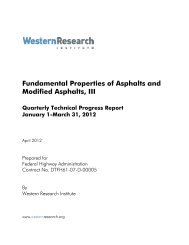Fundamental Properties of Asphalts and Modified Asphalts, III
Fundamental Properties of Asphalts and Modified Asphalts, III
Fundamental Properties of Asphalts and Modified Asphalts, III
You also want an ePaper? Increase the reach of your titles
YUMPU automatically turns print PDFs into web optimized ePapers that Google loves.
figure 2-2.2.19 to show the correlation <strong>of</strong> rheological properties to field cracking performance. It<br />
can be seen that different asphalts oxidized to the same stiffness have different phase angles.<br />
The higher phase angle at the same oxidation stiffness indicates the asphalt has better flow<br />
properties. Based on figure 2-2.2.19, asphalt AZ1-1 has the lowest (smallest) phase angle at the<br />
same oxidation stiffness, indicating this asphalt will tend to become more brittle earlier than the<br />
other three asphalts when oxidized to the same stiffness. From this figure, one can see that the<br />
ranking (cracking potential) from laboratory rheological data agrees well with field cracking<br />
performance. In other words, asphalt AZ1-1 has developed the most cracking so far, followed by<br />
asphalt AZ1-2, asphalt AZ1-4, <strong>and</strong> the least tendency to crack is asphalt AZ1-3.<br />
Complex Modulus, G*, Pa<br />
1e+7<br />
8e+6<br />
6e+6<br />
4e+6<br />
2e+6<br />
0<br />
Master Curve at 10 rad/s<br />
4th Year<br />
30 40 50 60 70 80<br />
Phase Angle, degree<br />
39<br />
Neat<br />
AZ1-1<br />
AZ1-2<br />
AZ1-3<br />
AZ1-4<br />
Figure 2-2.2.19. Complex modulus versus phase angle with respect to<br />
different aging times for four asphalts.<br />
To further elucidate how phase angle relates to the flow properties <strong>of</strong> asphalt binder, the phase<br />
angle was plotted against with reduced frequency (master curves) (figure 2-2.2.20) <strong>and</strong><br />
temperature (figure 2-2.2.21) for original asphalt, asphalt extracted from 4-year pavement, <strong>and</strong><br />
asphalt subjected to laboratory PAV aging at different aging times. A typical phase angle master<br />
curve plot is shown in figure 2-2.2.20. The phase angle decreases as a sigmoid shape as<br />
frequency increases. Figure 2-2.2.21 shows a similar plot for phase angle versus temperature.<br />
All solid symbols along with solid lines represent all laboratory aging at different aging times.<br />
The circular solid symbol represents the control sample, neat asphalt without any aging. Square,<br />
diamond, inverted triangle, <strong>and</strong> triangle solid symbols represent 96 hours (red), 192 hours<br />
(green), 336 hours (orange), <strong>and</strong> 504 hours (light blue), respectively, in PAV at 60°C. The<br />
hollow symbols along with dash lines all represent 4-year old shoulder pavement at different<br />
slices, top half inch (dark blue), 2 nd half inch (red), 3 rd half inch (dark purple) <strong>and</strong> bottom half<br />
inch (dark cyan). Careful examination shows that the data plotted in figure 2-2.2.21 are





